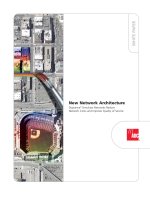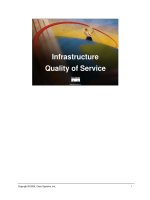Tài liệu Campus Quality of Service pdf
Bạn đang xem bản rút gọn của tài liệu. Xem và tải ngay bản đầy đủ của tài liệu tại đây (608.16 KB, 22 trang )
© 2000, Cisco Systems, Inc. 1
© 2000, Cisco Systems, Inc.
Campus
Quality of Service
© 2000, Cisco Systems, Inc. 2
© 2000, Cisco Systems, Inc. www.cisco.com econ_387_05_010.ppt
Objectives
Objectives
Upon completion of this module, you will be able to
perform the following tasks:
• Describe the characteristics of QoS in the
campus
• Describe reasons why campus QoS is needed
• Describe the steps required to implement QoS in
the campus
• Describe solutions available to solve campus
QoS problems
• Explain IP Precedence
• Define Differential Service Code Point
The objective of this module is to define the quality of service (QoS) tools which must be
implemented to provide a voice-enabled transport service for IP telephony.
A QoS-enabled transport infrastructure is the prime prerequisite for end-to-end IP
telephony, which is covered in the following chapters.
The key design consideration here is to make sure the proper hardware and Cisco IOS
releases are in place, along with sufficient bandwidth, to support the added requirements
that voice will place on a data network.
© 2000, Cisco Systems, Inc. 3
© 2000, Cisco Systems, Inc. www.cisco.com econ_387_05_010.ppt
Campus QoS
Campus QoS
Campus QoS Issues
–Prioritization (Marking and Queuing)
© 2000, Cisco Systems, Inc. 4
© 2000, Cisco Systems, Inc. www.cisco.com econ_387_05_010.ppt
Campus QoS
Campus QoS
Distribution
Layer 3
Core
Layer 3
Access
Layer 2
WAN
WAN
Internet
Internet
PSTN
PSTN
Distribution
Layer 3
Access
Layer 2
Server Farm
Server Farm
•Hierarchical design
•Minimize Layer 2
•Switched 10/100 to
desktop
•GE/GEC trunks
•Fast convergence
•Define & enforce a
trust boundary.
•Over-provision &
undersubscribe BW
Enterprise customers are building hierarchical campus networks. These networks minimize
the use of Layer 2 technology and attempt to solve problems if possible with Layer 3, for
example, route around problems.
This graphic illustrates a typical network of today. The 10/100 Ethernet to the desktop has
to be switched. Do not support IP Telephony in any way, shape, or form over shared media;
switched to the desktop is required, ideally at 100 Mb. Gigabit Ethernet trunks should be
overprovisioned, and undersubscribed in a campus network.
QoS in the campus today is like an air bag. It’s there. It’s very comforting that it’s there,
but who wants to use it every day? If using it every day, a large call bill develops. All of
these QoS mechanisms are important and have to be there because they add value to the
network.
Another important factor is the establishment of a trusted boundary within a network. The
PC, the attached device, has typically been viewed as something to entrust, just based on the
port. But now that voice is running - and in the future, video and data - it is imperative that
this trust boundary be defined.
Finally, some characteristics must be identified, some way to identify voice, versus video,
versus data on the ingress to the network itself.
© 2000, Cisco Systems, Inc. 5
© 2000, Cisco Systems, Inc. www.cisco.com econ_387_05_010.ppt
Need for Campus QoS
Need for Campus QoS
Aggregation
Speed Mismatch
10 Mbps
1000 Mbps
Switching Fabric
Many-to-One
Link Utilization 60%
Example:
100-Mbps Link
Packets from Different Applications
Packets that Made It Through;
Rest Are Dropped
Buffers
• Any of the above
scenarios could result
in packet loss and/or
delay.
• Delay-sensitive
applications like voice
need QoS.
Why is QoS needed in the campus? One reason is speed mismatches, going from Gigabit
Ethernet to Fast Ethernet. Many-to-one means having a lot of things coming down to a
common link and oversubscribing it. If there is a Catalyst® 6000 with 384 Fast Ethernet
ports on it, it is possible to oversubscribe the uplink. So potentially, all of these things are
reasons to be able to identify voice, and perhaps treat it differently from data.
© 2000, Cisco Systems, Inc. 6
© 2000, Cisco Systems, Inc. www.cisco.com econ_387_05_010.ppt
Steps for Campus QoS
Steps for Campus QoS
2 Steps for Campus QoS Implementation
• Marking
Marking the packet with a specific priority.
Establish a trust boundary.
• Queuing
Assigning packets to one of multiple queues
(based on classification) for expedited treatment
through the network.
The two steps required for campus QoS are marking and queuing. It is necessary to
distinguish among voice, video, and data traffic. The traffic must be marked and a trust
boundary established. If the traffic is marked at the edge, hopefully, the further into the
network, the less the worry about trusting a given packet.
Next, use that criteria, however the traffic has been classified, to give it preferential
treatment, perhaps in the wide-area networks. If you can classify at the edge, as you go
through the wide-area network you can use that classification mechanism as the entrance
criteria, for example, to a priority queue for the WAN.
The second step is queuing, or assigning packets to one of multiple queues, based on the
classification technique employed, within the campus for expedited treatment through the
network.
© 2000, Cisco Systems, Inc. 7
© 2000, Cisco Systems, Inc. www. cisco.com econ _387_05_010. ppt
Marking
What is it?
Marking
What is it?
Marking is the QoS feature component
that “colors” a packet so that it can be
identified and distinguished among other
packets in QoS treatment:
–Differentiated Services Code Point (DSCP)
–IP Precedence
–QoS-Group
–802.1p
Packets entering the network may have been marked previously. If this marking
is from a trusted source, then classification may be based on the previous mark.
If the marking is not from a trusted source, then classification may be used to
determine what the new marking should be.
Marking can occur at Layer 2 or Layer 3, however many QoS features are based
on the IP Precedence bit or Differentiated Services Code Point (DSCP) settings.
There are methods of marking that will map Layer 2 Class of Service (CoS) bits
to Layer 3 IP Precedence or DSCP settings.
A QoS-group is internal to a router. It allows us to virtually mark packets as they
come into a router, then use that virtual marking for outbound policy. The
biggest advantage to virtual marking is that it does not alter the traffic passing
through the router.
© 2000, Cisco Systems, Inc. 8
© 2000, Cisco Systems, Inc. www.cisco.com econ_387_05_010.ppt
Solutions for
Campus QoS Issues
Solutions for
Campus QoS Issues
• Marking
–CoS/ToS/DSCP
• Congestion avoidance (WRED)
• Scheduling & queuing
–Priority queuing
–WRR
• Policing
What are the available classification schemes?
There is CoS, a Layer 2 scheme, 802.1P, and 802.1Q.
At Layer 3 are the preferred schemes. However, it’s not always possible to classify at Layer
3. The benefit of classifying at Layer 3 is that classification potentially follows a packet
from the source to the destination, irrespective of how many hops it traverses. This is true
as long as you don't re-classify.
Congestion avoidance schemes, such as WRED, don’t really do a great deal for voice
directly. It uses the UDP, so dropping a packet is not going to help much. But it will
improve handling TCP traffic, allowing you to throttle it back which helps voice indirectly.
Another issue is queuing and scheduling. The current preferred queuing mechanism is
LLQ, which is really PQ-CBWFQ is a rigid traffic prioritization scheme: if packet A has a
higher priority than packet B, packet A always goes through the interface before packet B.
When you define an interface's QoS property as priority queuing, four queues are
automatically created on the interface: high, medium, normal, and low. Packets are placed
in these queues based on priority queuing policies you define on the interface. Unclassified
packets are placed in the normal queue. This allows you to exhaust the voice queue before
attempting to deliver other classes of traffic.









